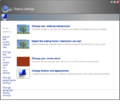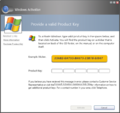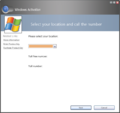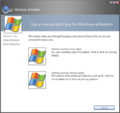Windows Longhorn build 4093 (main)
| Build of Windows Longhorn | |
 | |
| OS family | Windows NT |
|---|---|
| Version number | 6.0 |
| Build number | 4093 |
| Architecture | x86 |
| Build lab | main |
| Compiled on | 2004-08-19 |
| Expiration date | |
| Timebomb | +180 days after original install date |
| SKUs | |
| Professional | |
| Product key | |
| TCP8W-T8PQJ-WWRRH-QH76C-99FBW | |
| About dialog | |
Windows Longhorn build 4093 (main) is the last main branch compile of the original Longhorn project before development was reset with build 3790.1232. This build was shared with a Windows Preinstallation Environment from build 4033 at the AeroXperience forum on 28 August 2006,[1] shortly after the closure of the original OSBetaArchive.com, and was labeled as a farewell release. Later, a fixed ISO with a 4093 PE was shared at longhorn.ms on 1 May 2014. This build is largely unstable; a hallmark of which was typical of most Longhorn builds found in the late 40xx range. It was also the last pre-reset Longhorn build to be available, and one of the final builds to be compiled by Microsoft under the old codebase.
Many applications and features are unstable works-in-progress, and might not function as intended. The development reset began sometime within four hours and fourteen minutes after the compilation of this build, at 16:29 (PDT). Development transitioned over to a new codebase (which prior to the reset was already in the works from as early as 3 August 2004) and was based on a work-in-progress version of Windows Server 2003 Service Pack 1. The codebase would later evolve to become Windows Vista.
While this build is only available in the Professional SKU, a Home edition is mentioned in the Activation Wizard discussed later in the article.
Background[edit | edit source]
Microsoft faced numerous unsolvable fundamental problems throughout work on the original Longhorn project such as stability issues (e.g.: memory leaks and system crashes), organizational management problems (such as lack of team morale and an unworkable build lab system) and feature creep, additionally compounded by the significant lack of work done to optimize the operating system and the use of relatively new or otherwise unfinished technologies such as the .NET Framework, Avalon and Managed C++ - patterns of which would eventually allude to development hell. Because of this, the project's development was ultimately reset and its underlying codebase switched to the latest mainline compile of Windows Server 2003 Service Pack 1, which was still in the works at the time. In addition, its planned feature set was reconsidered and a near-total ban on usage of .NET was instituted within the Windows source tree, with an exemption being applied against a very limited subset of system components.
From build 3790.1232 onwards, the Longhorn development team would set out to borrow, reintegrate and/or rewrite code from older Longhorn builds and adapt it to a stable codebase; examples of such functionality would be the User-Mode Driver Framework (introduced in build 5001) and the kernel-mode DirectX Graphics Interface (DXGI) system driver.
Setup[edit | edit source]
Although setup is mostly similar to previous builds of Windows Longhorn, a few minor adjustments were made across a number of pages.
Features[edit | edit source]
User Account Control[edit | edit source]
The User Account Control functionality has received a few uplifts in this build, where the unknown application dialog has received a small design change.
MXPlayer[edit | edit source]
A version of Windows Media Player intended to replace the traditional app is present in this build under a different file name; however, it is less stable than what was originally envisioned in the previous builds. The redesigned application can be run from the Windows installation directory, under C:\Windows\MXPlayer.exe.
Avalon Applications[edit | edit source]
This build includes an Avalon-based Windows Movie Maker application. However, the application is largely unfinished and the debug prompts/assertion error messages that plague it make the application nearly unusable. The Avalon Movie Maker can be found in C:\Program Files\Movie Maker 3\MovieMaker.exe.
The overhauled Display Properties dialog first seen in build 3683 also marks a return in this build; however, most of the links found in the application simply redirect to the older control panel applet found in Windows XP. A power settings dialog and a Wireless Presentation application based on the Avalon framework are also present in this build. The applets are named as LHDesk.exe, PowerCpl.exe, and WPWizard.exe, all of which are found respectively in the SYSTEM32 folder.
A prototype Color Management control panel (based on Avalon) can be found in this build as well. During the componentization procedure, the accidental omission of a specific Control Panel library in the manifest led to the executable not being present in the component store and its main DLL component becoming duplicated; the affected component in question is microsoft.windows.controlpanel.colormanagement. However, it is believed that the missing executable was a stub, as the main application code is found through another component named system.windows.explorer.controlpanel.colormanagement.dll. The launcher stub for the former can be reproduced using an IDE. The applet itself is largely unfinished, as shown by the other pages accessible on the right either crashing or doing nothing due to the lack of functions found within the DLL file.
Managed DWM[edit | edit source]
This build, like build 4088, includes a new implementation of the Desktop Window Manager, rewritten in .NET managed code. This can be found in the C:\build\filerepository\windowmanager_a2ea4897 folder, with the name WindowManager.exe. It is meant to be installed using the cm tool, but this will fail due to service registration not yet being implemented in the new managed DWM. See the Windows Aero page for instructions to enable.
Border styles[edit | edit source]
Theme borders[edit | edit source]
Simple XAML borders[edit | edit source]
Borders loaded from Jade theme, with MILExplorer and patched WCPClient
DWM borders, loaded from Jade theme
DWM borders, loaded from Slate theme
Miscellaneous[edit | edit source]
Prototype Windows Product Activation[edit | edit source]
The .NET Framework library folder (C:\Windows\Microsoft.NET\Windows\v6.0.4030\) contains an executable file named LicenseUI.exe, which includes dialogs for a prototype design of the Windows Product Activation functionalities; however, most dialogs do not load and those that remain are lacking in terms of design and functionality and have a chance of crashing. The remaining dialogs can be run via C:\Windows\Microsoft.NET\Windows\v6.0.4030\LicenseUI.exe -type=w -dlg=Y, where Y is a number from 1 through 10. Only dialog options 2, 3 and 6 load correctly.
The sixth dialog contains options which refer to both the Home and Premium SKUs, indicating that at some point in development, the SKUs would be included in a commercial release of the Longhorn project; these SKUs would later respectively turn into the Home Basic/Premium and Ultimate editions in the final release of Windows Vista. A full list of LicenseUI pages can be found here.
Migration Wizard[edit | edit source]
An early Migration Wizard is present in this build. It opens in fullscreen, and, just like later builds, it ignores the current visual style.
Miscellaneous[edit | edit source]
- A new sound tray icon, which directs the user to the Sound and Devices Control Panel, has been added to the taskbar.
- The Games library has received a few minor design uplifts. As a side effect of componentization, all shortcuts to the inbox games have been removed from the Library; although the executable files for the games themselves are still present in the operating system.
- The shutdown/restart/stand by choices have been uplifted, now including an entirely revamped shutdown screen, prompting the user if they want to carry out said action.
Fixes[edit | edit source]
- The ability to use the Windows Classic visual style has been restored in this build as a registry modification is not needed anymore.
- The Hardware and Devices folder in the Control Panel has been made functional again.
- The video driver can properly initialize again without having to manually enable VGA mode after driver installation.
- The MS Shell Dlg 2 string value has changed from "Microsoft Sans Serif" back to "Tahoma" located at
HKEY_LOCAL_MACHINE\SOFTWARE\Microsoft\Windows NT\CurrentVersion\FontSubstitutesafter builds 4081–4088.
Bugs and quirks[edit | edit source]
Installation[edit | edit source]
- Much like later componentized builds, installation can take a long time and may often fail.
- Installation can hang for extended periods of time if it is started on the current date, even though it has a non-functional timebomb.
- The hardware portion of setup has issues with MUI handling, and may fail to copy certain files. It is advised to skip file copying if the user is prompted to point to a specific file location. This issue largely depends on the hardware being used, regardless of what copy the build was installed from.
- On first logon and after completion of the hardware detection phase of setup, the Windows Explorer application may fail to launch. A workaround is to press Ctrl+Alt+Del to log off and then log on again.
- The screen color depth is set to 16-bit by default, rather than 32-bit.
Upgrade[edit | edit source]
Attempting to upgrade from other builds is not possible as one of two outcomes may occur:
- A bugcheck with error code
0x7Eafter the second reboot. This is commonly observed when trying to upgrade from non-componentized builds, such as 4074 (through a registry tweak that reports it as a componentized build). - An error during the file copy phase.
WinPE[edit | edit source]
The mouse driver in this build's Windows Preinstallation Environment does not function on specific hardware configurations or hypervisors, and may require a keyboard to navigate through the installation procedure. This issue appears to be largely related to using a PS/2 mouse, as most ordinary USB mice appear to function properly.
Task Manager[edit | edit source]
The Task Manager in this build tends to hang when launching a new task if the Windows Explorer application is not running.
Timebomb[edit | edit source]
Unlike other Longhorn builds, this build contains a mostly non-functional timebomb, and as a result, can be installed on the current date. If, however, it is installed on the current date, it can be triggered randomly at boot.
Outlook Express[edit | edit source]
Outlook Express does not start due to issues with registry access and missing WinFS dependencies.
Explorer[edit | edit source]
- CD and DVD drives behave like local disks. This will cause the system to throw out notifications about low disk space. Floppy drives behave like local disks only if a CD is inserted in the system.
- Help and Support crashes Explorer.
- Explorer will crash after adding the display tile in sidebar and will not launch again. A workaround is to create a new account via the Command Prompt or by removing the affected tile through a registry modification.
- Text may overlap certain visual elements in the Game Library.
- Sometimes, icons may not show correctly on the desktop and Start menu unless Explorer is restarted.
- Viewing large folders might cause Explorer not to properly load all directories (which is true for the System32 directory). Refreshing Explorer several times fixes this.
- When the Aero taskbar and sidebar are enabled, the "Minimize Sidebar" button will not reverse when the Sidebar is already minimized.
- The full Aero does not render even if the
MILExplorerkey is set to 1, due to the function relying on the previous unmanaged DWM.- Therefore, the Aero glass shaders drawn by the managed DWM do not become opaque even if the window is maximized.
Themes[edit | edit source]
Changing the theme will leave the taskbar without a visual style, reminiscent of build 4074's theming service bug. This can be fixed by restarting explorer.exe or changing to another theme (except Windows Classic).
The navigation buttons of Windows Explorer, Internet Explorer and other Avalon-based applications will disappear if the application is in use.
Control Panel[edit | edit source]
- By default, the Phone and Modem Options Control Panel applet name is empty.
- Sometimes, Computer Management will display script errors due to missing registry entries.
Drivers[edit | edit source]
- This build does not install the default monitor driver by default and may need to be installed manually. As a result, changing the display resolution will not ask for confirmation.
- The Hardware Abstraction Layer device may show up as an unrecognized device.
- Many driver categories lack their respective icons.
Managed DWM[edit | edit source]
- Some display glitches can occur, such as the presence of a black square on the screen or tooltips not disappearing after a certain amount of time.
- The title bar uses the Arial font regardless of the theme choosen.
- Opening elements such as the Start Menu, flyouts, and windows will trigger a fade effect as they appear.
Compatibility[edit | edit source]
The VMware sound drivers have a large chance of ceasing to function for no specific reason, regardless of whether hardware-based sound acceleration is enabled or not.
Movie Maker[edit | edit source]
The Movie Maker does not function, as it relies on dependencies that are not included in this build.
Safe mode[edit | edit source]
The Safe mode functionality does not work in this build and results in a bugcheck with code 0x0000007B (INACCESSIBLE_BOOT_DEVICE). This is because the SafeBoot key, located at HKEY_LOCAL_MACHINE\SYSTEM\CurrentControlSet\Control, is largely incomplete and lacks most entries necessary for Safe Mode to work. Restoring the key from an earlier build with working safe mode allows this build to boot properly, but the video driver will not initialize properly. As a result, the operating system will freeze as it transitions into graphical mode, so Safe Mode is currently not known to work on these pre-reset Longhorn componentized builds.
Other bugs[edit | edit source]
- Opening the "Extended" tab in
services.mscmay cause a script error. - Pressing the secure attention key combination (Ctrl+Alt+Del) may result in an "Access is denied" error.























































